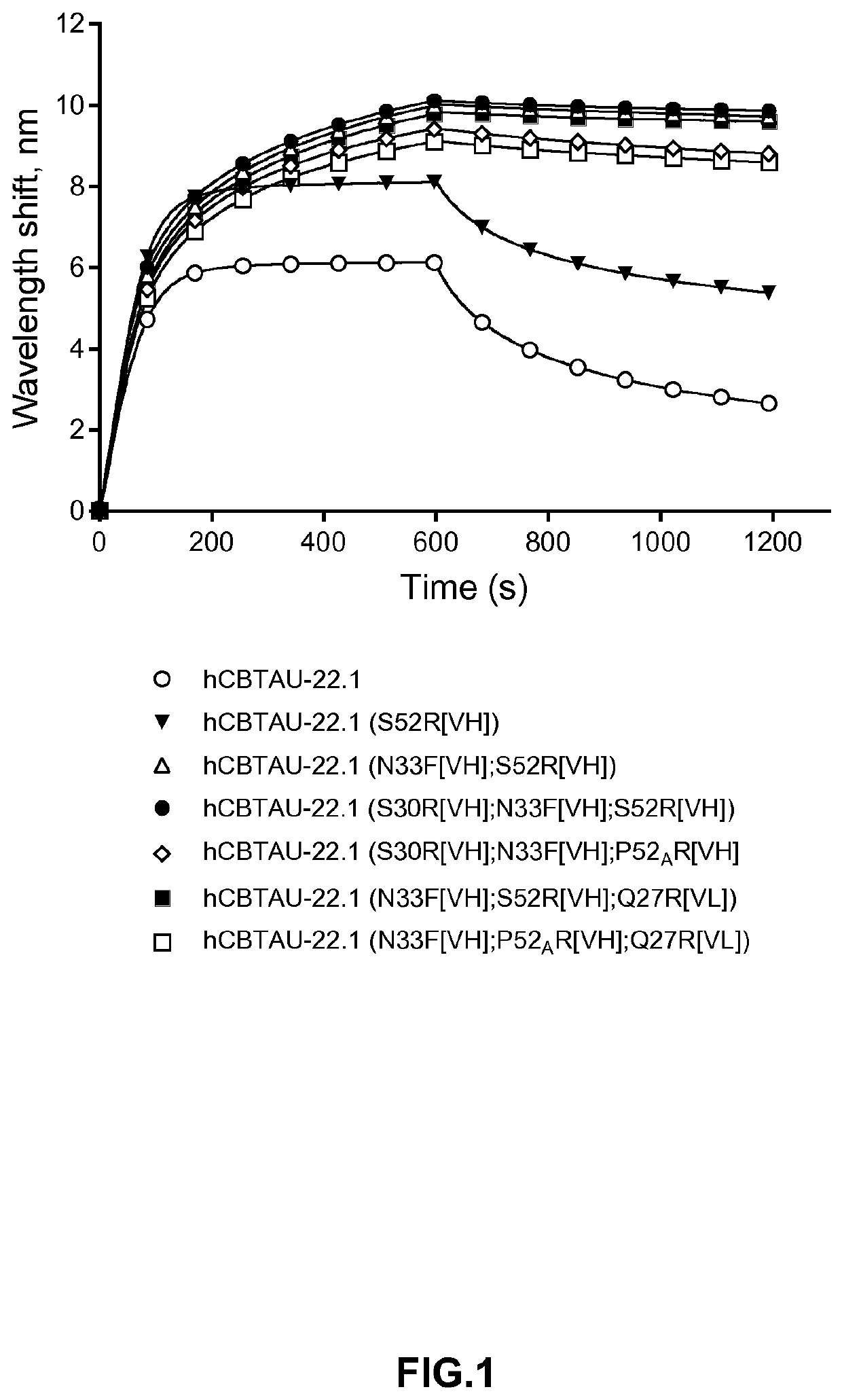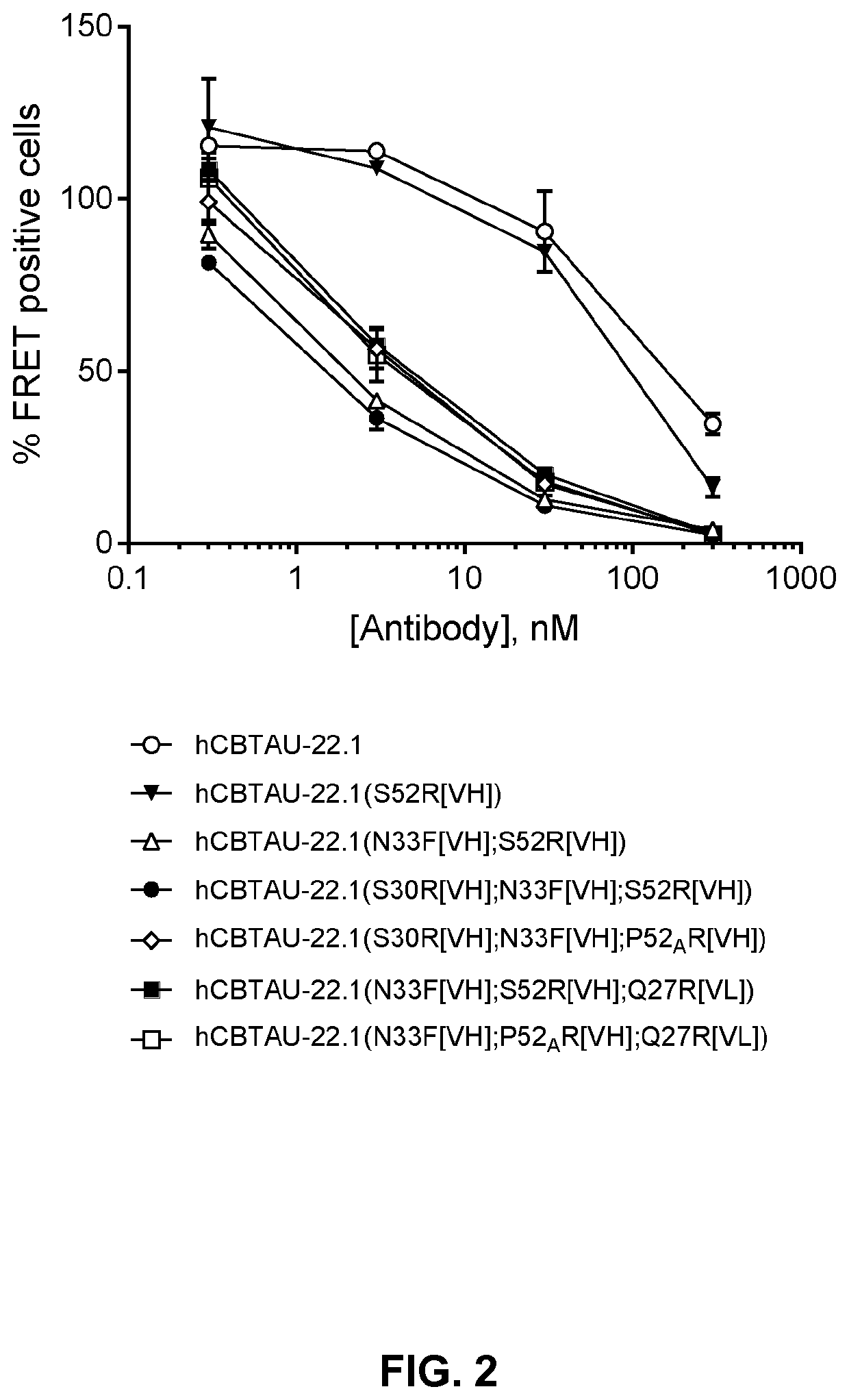Binding molecules that specifically bind to tau
a technology of binding molecules and tau, applied in the field of medicine, can solve the problems of higher opportunity costs and likely higher costs, and achieve the effects of preventing mediating uptake and degradation of tau aggregates, and inhibiting the spread of tau aggregation
- Summary
- Abstract
- Description
- Claims
- Application Information
AI Technical Summary
Benefits of technology
Problems solved by technology
Method used
Image
Examples
example 1
Preparation of Novel Antibodies of Invention
[0111]Human IgG1 antibodies were constructed by cloning the heavy (VH) and light (VL) chain variable regions into a single expression vector containing IgG constant regions. Plasmids encoding the sequences corresponding to human anti-tau mAbs were transiently transfected in human embryonic kidney 293-derived Expi293FTM cells (Thermo Fisher) and 7 days post transfection, the expressed antibodies were purified from the culture medium by MabSelect SuRe (GE Healthcare) Protein A affinity chromatography. IgGs were eluted from the column with 100 mM sodium citrate buffer, pH 3.5 which was immediately buffer exchanged into PBS, pH 7.4 using a self-packed Sephadex G-25 column (GE Healthcare). Each antibody was quality controlled by SDS page and size exclusion chromatography coupled with multi angle light scattering (SEC-MALS) and was further confirmed for reactivity to cognate tau peptide by Octet biolayer interferometry.
example 2
Octet Biolayer Interferometry Based Association and Dissociation Profiles of the Antibodies to the Cognate Tau Peptide V1089-24
[0112]The tau peptide V1089-24, comprising the amino acid sequence 412SSTGSIDMVDpSPQLATLA429 (SEQ ID NO: 9), was bound via N-terminal biotin to a streptavidin biosensor. Association (0-600 s) was followed upon immersing the sensor in solution containing the antibodies according to the invention (100 nM), whereas dissociation (600-1200 s) was followed by moving the sensor containing the protein complex into kinetic buffer. The buffer used for these experiments was obtained by diluting 10 fold the 1033‘Pall ForteBio's Kinetics Buffer’ in PBS. Improvement in affinity is confirmed by larger shift in the wavelength (nm) and / or slower dissociation kinetics.
[0113]The results are shown in FIG. 1. As can be seen, the new binding molecules of the invention showed an improved binding profile to Tau peptide (SEQ ID NO: 9), as compared to the previously described antibod...
example 3
Ability of the Antibodies to Deplete Seeds from AD Brain Homogenates
[0114]Homogenates containing tau seeds were generated from cryopreserved human AD brain tissue. In immunodepletion assays the seeds were incubated with test antibody and removed from the solution with protein G Dynabeads. The depleted supernatant (named ‘immunodepleted fraction’) was tested for residual seeding capacity in the chromophore-K18-containing HEK293 cells and analyzed by Flow cytometry.
[0115]The FRET biosensor cells are HEK cells stably expressing K18 / P301S-CFP and K18 / P301S-YFP and were plated in 96-well plate format. Immunodepleted fractions were transfected in the cells by pre-mixing the fractions with Lipofectamine2000 to increase the assay window and incubated on the recipient FRET biosensor cells for 2 days after which the cells were trypsinized and the percentage of FRET positive cells was quantified by Flow cytometry. A FRET signal can only be measured when the K18 reporter proteins form aggregate...
PUM
| Property | Measurement | Unit |
|---|---|---|
| Aggregation | aaaaa | aaaaa |
Abstract
Description
Claims
Application Information
 Login to View More
Login to View More - R&D
- Intellectual Property
- Life Sciences
- Materials
- Tech Scout
- Unparalleled Data Quality
- Higher Quality Content
- 60% Fewer Hallucinations
Browse by: Latest US Patents, China's latest patents, Technical Efficacy Thesaurus, Application Domain, Technology Topic, Popular Technical Reports.
© 2025 PatSnap. All rights reserved.Legal|Privacy policy|Modern Slavery Act Transparency Statement|Sitemap|About US| Contact US: help@patsnap.com


